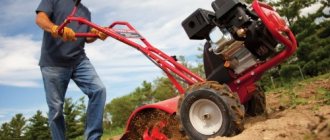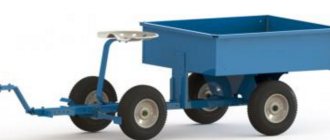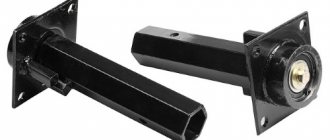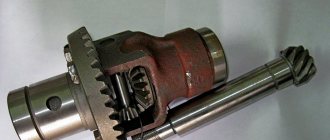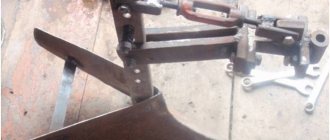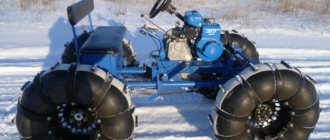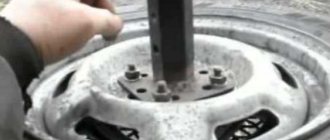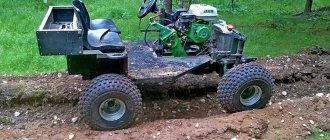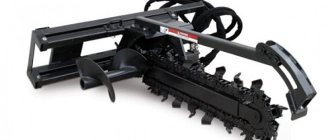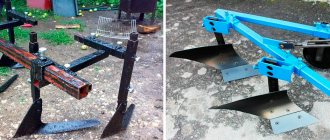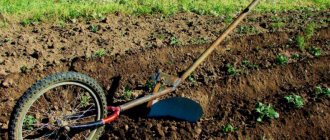When purchasing a walk-behind tractor for their household, people focus on engine power and equipment performance. However, the performance of the unit is directly affected by the wheels for the walk-behind tractor. The chassis allows the unit to move around the garden.
Factory models are usually equipped with the correct wheelset. But given the loads on this structural element, the wheels often break. Accordingly, the farmer has to buy the failed part himself.
We will advise you on how to choose suitable wheels and suggest options for making your own chassis yourself.
Main varieties
When deciding how to choose wheels for a walk-behind tractor, it is important to first find out what types there are. According to the classification, there are three varieties:
- pneumatic. Their design includes a rubber tire and tube;
- metal with lugs. A special feature of this wheelbase is increased cross-country ability;
- rubber. This is a one-piece design consisting of a rim and rubber.
Which option should you prefer? The choice should be made based on the operating conditions of the walk-behind tractor. For example, plowing too wet soil or a clayey area will be quite difficult if you do not use equipment equipped with metal lug wheels. Their teeth go deep into the ground, which creates additional force to ensure that the walk-behind tractor moves in the desired direction.
If the unit is used for harvesting or planting, for example, potatoes, in an area with normal soil, you can give preference to a pneumatic wheel model. If the soil is characterized by the presence of a large percentage of stones, then equipment equipped with a cast wheelbase is ideal for plowing the field. Such chassis elements demonstrate good resistance to mechanical damage. The main disadvantage of cast wheels is their heavy weight. Therefore, the latter are usually equipped with medium and heavy equipment.
Advice! To increase the performance of equipment under different weather conditions, it is recommended to purchase two types of wheels, for example, a pneumatic and a metal version with lugs. These are quick-change chassis elements, so there will be no problems with their installation.
Both universal samples (suitable for walk-behind tractors of all models and brands) and special versions (designed for a specific modification of equipment) are popular on the market. The first is preferred by those users who value every penny and do not want to pay twice. Special wheels are available in a wide price range, and you can order them if the walk-behind tractor you are using has a popular model.
Options for wheel design drawings for a walk-behind tractor
Factory configurations of wheels for a motor cultivator are classified according to the number of axles, as well as the principle of traction. Manufacturers produce home mini tractors, the design of which involves the movement of the unit due to:
- two wheelsets;
- paired wheel structure on one axle;
- one drive wheel;
- on three wheels.
Single-wheel mechanisms are often equipped with additional devices on the axle, which also serve as support for the structure. Analyze the model of your home cultivator to improve its functionality. Choose a durable, reliable material or a suitable base for making homemade chassis elements
Four wheel option
Small-sized agricultural tractors on four wheels are a miniature of a similar vehicle without a cabin. The configuration of the models allows the user to move on a walk-behind tractor.
To improve the factory configuration, you can replace only the drive pair or change all the disks. Choose one of the options to improve the performance of home agricultural equipment:
- equipping factory tires with additional protectors;
- putting new tires with a textured pattern on the wheels;
- installation of wheelsets of different radii on the axles - larger ones under the mechanisms, smaller ones under the driven part;
- installation of car wheels.
Important!
Designing wheels is an important stage in improving a walk-behind tractor, at which it is necessary to make accurate calculations of the optimal dimensions, arrangement of elements, and locations for drilling fasteners.
Four-wheeled walk-behind tractors are classified as heavy-duty models. A number of machines are configured with non-removable wheel elements. Before modifying a mini tractor, make a drawing according to which you plan to improve.
On one wheel set
Two-wheeled motor cultivators are equipped with one axle with a pair of wheel elements. The platform with the installed engine is controlled by the user using handles. Installing a passable wheelset will solve the problem with:
- slippage;
- slippage;
- filling the poorly expressed tread pattern with earth;
- poor handling;
- insufficient plowing depth, etc.
Draw a sketch of one element on paper yourself or make a drawing in a computer program. In the figure, indicate the diameter of the disk, the location of the holes for the axle, fastenings, and their dimensions.
With one driving wheel
Single-wheeled cultivators are devices in the form of a wheel element in a tire with a pronounced tread. The speed of work and efficiency when performing farming work depend on the permeability of the disk.
When preparing a drawing for replacing the drive wheel, use the following recommendations:
- select the diameter of the wheel element similar to the factory configuration;
- choose materials with greater weight when making a wheel yourself;
- replace the rubber with a more textured and wider one.
The walk-behind tractor on one wheel is controlled by manual manipulation. It will be easier for you to drive a design with a wide wheel and a powerful tread.
Three-wheeled models
On small-sized agricultural tractors for cultivating a summer cottage with three wheels, the front element performs the function of following a given trajectory. The rear wheel pair is supplied with torque from the unit engine. In most models, the chassis located at the front is made of a larger diameter.
To design the replacement of wheels on a single-axle small-sized tractor, use the following recommendations:
- calculate the same radius of the wheel and tire that is provided in the factory configuration. Installing a smaller or larger wheel in diameter will make the mechanisms work incorrectly;
- make identical wheel elements. Replacing wheels with different tread patterns or different weights will complicate the use of the mini tractor.
When making a drawing with your own hands, take as a basis the model designed by the manufacturer. Consider the full radius of the elements. You can design a disc with a smaller diameter, but install thick tires on it, and vice versa.
Criterias of choice
Any garden equipment is available in several variations. The chassis for the walk-behind tractor is no exception to this rule. If you look at the assortment of any store that sells spare parts for walk-behind tractors, you will see that there are three types of wheels:
- Pneumatic. Such products have a rubber tire and inner tube.
- Rubber. Monolithic design, which consists of a rim and durable rubber.
- Lugs. Metal elements aimed at increasing the cross-country ability of vehicles.
The difficulty of choice lies in determining the operating conditions of the equipment. For example, for processing clay areas or wet soil, it is recommended to use lugs.
A walk-behind tractor equipped with conventional rubber wheels will not show good performance in difficult conditions. In addition, you should focus on the wheel radius and tread pattern.
Wheel sets belong to the category of quick-change equipment, so it makes sense to purchase two types of chassis. For example, lugs and pneumatic wheels. This will allow the equipment to operate in different weather conditions.
What wheels can be put on a walk-behind tractor? Here a lot depends on the intended use of the technology. If the unit is needed for planting and harvesting work, you can choose pneumatic wheels.
For primary cultivation of virgin soil and soil with a high content of stones, it is better to use cast wheels. They receive virtually no mechanical damage due to the absence of an internal chamber.
However, such elements have increased weight, so they are installed on medium and heavy walk-behind tractors.
The lugs not only increase the maneuverability of the equipment, but also increase its productivity. The teeth enter the soil, which creates additional force to move the unit in a given direction.
Such elements are used mainly for arable work on large areas of land. It is not advisable to use lugs on a small plot of land.
Tips for choosing
- Not all wheels can be installed on Neva walk-behind tractors. Large ones will not “sit” well; it is very important to respect the diameter. Homemade ones are only suitable if they were taken from a Moskvich or Zhiguli and well adapted.
- When purchasing, the user should know that when using a trailer or in the case when the walk-behind tractor is used as a traction equipment, metal wheels will not work, they will ruin the asphalt surface, so they install pneumatic ones.
- You should always take into account what the main purpose of using the walk-behind tractor is. If you plan to plow virgin soil, then wide models will help, which will also be indispensable when digging up potatoes.
- Universal models can be used on any walk-behind tractor, regardless of its type. This is the option when you don’t want to pay twice. On average, such wheels cost 5 thousand rubles.
- In specialized stores there will always be wheels designed for a specific walk-behind tractor. The cost may vary depending on the manufacturer, and low price is not always good quality. They may differ in characteristics and configuration.
- If the user has an expensive walk-behind tractor, then you can find chamber products for it, but they are very expensive, although they do not have many advantages. On average this is 10 thousand rubles.
Making homemade lugs
Sometimes pneumatic tires can slip (soft ground, slush after rain, ice) and your work can go down the drain. For better adhesion to the soil, reliable devices are needed. These are ordinary lugs.
Figure 1. Zhiguli wheels on a cultivator.
You can, of course, buy them in a store, but not everyone wants to spend money on something that is easy to make yourself, and from “waste” materials. Moreover, there are only two requirements for them, and both are necessary to ensure reliable grip:
- Weight 20-30 kg.
- Digging into the ground.
There are many options for DIY lug wheels. We will focus on two of them. For their manufacture, the main tools are:
- Bulgarian;
- welding machine.
To complete the first option, you will need metal strips (about 5 mm thick) and car rims. Their diameter depends on the size of the cultivator blades. Many people take Lada wheels as the best option. Picture 1.
Figure 2. Homemade lugs for the cultivator.
The method for making soil hooks is very simple:
- cut strips with a grinder so that their length is approximately one and a half times the width of the disks;
- they are bent in a vice at an angle so that they are inserted between the two sides of the disk;
- distribute the strips evenly and weld them into place;
- strengthen the resulting lugs on the axle.
The second option is more difficult. For it, they take a sheet of thick metal, mark it and cut out something like a large bicycle sprocket or a ratchet from a watch. Next, parts of the resulting beams are bent and metal plates are welded to them. Figure 2.
Description
The installation inner diameter of the bushing is 25 or 30 mm. The full length of the hub is 310 mm (does not require additional extensions; due to its length, it is installed quite tightly directly onto the gearbox shaft, which minimizes bending and runout of the wheels than when using conventional axle extensions with standard hubs in each of which, unfortunately, there are huge gaps, which gives a large curvature)
The hole for the locking pin is 10.2 mm (at a distance of 25 mm from the edge) The bolt pattern of the mounting holes for the walk-behind tractor wheels: 5x139.7 - for Niva wheels, centering collar D 98 mm, holes for M12 stud; (the photos below show exactly this option for Niva wheels)
(It is possible to change the length of these hubs to suit your required track, as well as the dimensions of the mounting holes, bolt patterns, flange diameter, as well as the thickness of the flange for any wheel or lug as agreed with the Customer) The outer diameter of the disk is 100-175 mm (depending on the bolt pattern and wheel used)
The thickness of the disk sheet is 6 mm (the disk is sharpened from a sheet 10 mm thick only after welding to the bushing, to eliminate runout and maintain perpendicularity of the installation plane of the disk and wheel to the axis of rotation, the thickness of the centering shoulder is 4 mm, diameter is 58-98 mm - the same depends on the wheel rim)
Bushing wall thickness - 10 mm (The bushing is made of solid round timber with a diameter of 50 mm, material St. 45, the hole is drilled and machined with a cutter to dimensions 30 0.15 mm for tight installation on the gearbox shaft with minimal clearance) Material - carbon steel This hub is used for connecting the output shaft of a walk-behind tractor with a diameter of 25 and 30 mm with various flange lugs and walk-behind tractor or car wheels, without the use of adapters and extensions, replaces standard conventional extensions and conventional walk-behind tractor hubs, but is many times superior to them in quality and service life, which ultimately reduces load on the gearbox and the cost of its repair.
Delivery set: Extended weighted walk-behind tractor hub for Niva wheels GBM-070-30-310 - 2 pcs.
Similar names for this product: — Walk-behind tractor salute hub; — Motoblock Neva wheel hub; — Motoblock agate hub; — The hub of the walk-behind tractor cascade; — Vase hub for a walk-behind tractor; — Walk-behind tractor hub for Niva wheels; — Motoblock on Zhiguli hubs; — Universal hub for walk-behind tractor.
Do it yourself
Now let's talk about how to make wheels for a walk-behind tractor yourself. Let us immediately clarify that creating pneumatic and cast wheels at home is in principle impossible.
And why reinvent the wheel if you can equip garden equipment with tires from a car or motorcycle. You just need to install a suitable hub and you can get to work.
It's a different matter when it comes to lugs. You can actually make such homemade wheels for a walk-behind tractor yourself. Here is a basic assembly diagram:
- We take old wheels from the car. Please note that only the rim is needed. The diameter of the wheels depends on the power of the walk-behind tractor, given that the design will be all-metal, the weight will be considerable.
- We weld metal plates to the disks. The edges of the plates should touch the edge of the rim. This is an important structural element, so the plates are welded along the entire outer radius; they can be secured with bolts to increase reliability.
- We weld the teeth to the metal plate. They can be made from a corner, after cutting it into pieces of the required length. Please note that the distance between the teeth should not exceed 15-20 centimeters. Otherwise, the effectiveness of such wheels will be reduced to zero.
- We weld the axle shafts into the disk, supplement the structure with bearings and install the chassis on the walk-behind tractor.
You can make lugs from an old gas cylinder. In this case, you need to cut two rims, about 6-7 centimeters wide, and then proceed according to the above diagram.
In general, lugs can be constructed from any available material that has the shape of a circle. The main thing is to show desire and apply a little skill.
Wheel extensions for walk-behind tractor
Axle extensions allow you to significantly expand the wheelbase of the walk-behind tractor. With their help, the walk-behind tractor will be more stable at any track width, and balancing will also be significantly increased. You can add additional wheels on each side, which will increase cross-country ability or create it where it is practically impossible.
Extension Cords
In addition, extension cords also perform such important functions as:
- carrying out difficult work and on heavy types of soil;
- equipment equipped with extensions can be used on uneven areas and on any type of terrain, including hilly, rugged terrain, ravines, pits, and so on;
- the walk-behind tractor will not slip and fall over with heavy attachments, as is often the case with narrow wheels or extension cords without additional equipment;
- Cross-country ability and maneuverability are greatly increased thanks to extensions;
- Extensions are indispensable for installing additional lugs, iron and pneumatic wheels on the walk-behind tractor.
DIY making at home
This is done as follows:
- two pipes of equal length with a diameter of 2 mm and above the diameter of the walk-behind tractor axis are required;
- each of them has a thread for screwing onto the axis of the walk-behind tractor;
- on the reverse sides of each of the pipes, holes are made two millimeters thinner than in the disks on wheels; if necessary, the pipes can be filed;
- After this, the wheels are fixed on the extensions with steel plates and secured with bolts.
Types of wheels for motor cultivators. How to choose them?
The motor cultivator itself is a mechanical structure used in household plots to facilitate agricultural work. In order for special equipment to perform its tasks 100%, all parts must be in good working order, especially the movement elements. The latter are divided into the following types:
- supporting;
- rubber;
- traction;
- metal with lugs;
- paired.
In a standard situation, the design of a motor cultivator is equipped with one wheel (support wheel), which takes the main load. This part of the unit is “responsible” for endurance and optimization during operation. There is an opinion that when performing some “earth” work the front wheel should be removed.
When choosing wheels for your inter-row cultivator, consider the following information.
- Traction and pneumatic wheels are known for their versatility and the presence of an original tread pattern. They are often called “Christmas trees” in everyday life. They are large in size (width exceeds 20 cm and diameter - 40 cm). The wheels allow the walk-behind tractor to easily move both on the road and on sticky soil. The impressive size of the wheels makes it possible to use the unit for plowing over large areas. Traction wheels are also great for a snow blower or cart. The amazing strength of rubber is popular due to its durability.
- Transport elements made of metal with lugs are weighted. Steel “teeth” push the cultivator forward and prevent it from “drowning” in the viscous clay.
- Rubber (solid) ones are installed not only on cultivators, but also on small tractors. They have a “rolling” property and are widely used in wooded (difficult) areas.
- Paired ones consist of 2 elements of the same size and shape. This design significantly increases the power of the unit and increases its speed. They have excellent contact with the surface and are easy to create at home. They also imply the possibility of quickly removing external elements.
Sometimes the basic set of wheels fails, and these elements must be made independently.
The cultivator is the “main assistant” for farmers and amateur gardeners on plots of land. The maneuverability and maneuverability of the unit directly depends on the quality and correct installation of the wheels. Selecting and changing transport elements on the cultivator is not difficult. The main thing is to take into account the characteristics of their types.
How to choose tires for a walk-behind tractor
The performance quality of a motor cultivator largely depends on what kind of tires are installed on its wheels. Therefore, you need to take the purchase of new tires seriously.
To choose them correctly, you need to familiarize yourself in advance with the list of characteristics that you should pay attention to during the purchase.
Characteristics
When choosing new tires, you need to pay special attention to their tread.
What should you consider when choosing new tires for a walk-behind tractor? Among the main characteristics, the following should be highlighted:
- Dimensions. It is better to use larger models, as they move much better on dirt roads.
- Protectors. Also, when choosing new tires, you need to carefully examine their tread. It should be high enough so that the equipment can move better over plowed soil.
- Maximum load. The wheels on the walk-behind tractor should easily support the weight of the unit itself with any attachments. It is recommended to choose tires with a maximum load of at least 150 kilograms.
- Weight. When choosing new tires for such equipment, this indicator must also be taken into account. It is advisable to choose products whose weight is in the range of 4-7 kilograms.
When choosing tires, you also need to consider their cost. There is no need to buy tires that are too cheap, as they will definitely be of poor quality. It's better to pay a little more to buy tires that will last a long time.
Rubber is a material that is added in large quantities when creating winter tires.
Types of wheels for motor cultivators. How to choose them?
The motor cultivator itself is a mechanical structure used in household plots to facilitate agricultural work. In order for special equipment to perform its tasks 100%, all parts must be in good working order, especially the movement elements. The latter are divided into the following types:
- supporting;
- rubber;
- traction;
- metal with lugs;
- paired.
In a standard situation, the design of a motor cultivator is equipped with one wheel (support wheel), which takes the main load. This part of the unit is “responsible” for endurance and optimization during operation. There is an opinion that when performing some “earth” work the front wheel should be removed.
When choosing wheels for your inter-row cultivator, consider the following information.
- Traction and pneumatic wheels are known for their versatility and the presence of an original tread pattern. They are often called “Christmas trees” in everyday life. They are large in size (width exceeds 20 cm and diameter - 40 cm). The wheels allow the walk-behind tractor to easily move both on the road and on sticky soil. The impressive size of the wheels makes it possible to use the unit for plowing over large areas. Traction wheels are also great for a snow blower or cart. The amazing strength of rubber is popular due to its durability.
- Transport elements made of metal with lugs are weighted. Steel “teeth” push the cultivator forward and prevent it from “drowning” in the viscous clay.
- Rubber (solid) ones are installed not only on cultivators, but also on small tractors. They have a “rolling” property and are widely used in wooded (difficult) areas.
- Paired ones consist of 2 elements of the same size and shape. This design significantly increases the power of the unit and increases its speed. They have excellent contact with the surface and are easy to create at home. They also imply the possibility of quickly removing external elements.
Sometimes the basic set of wheels fails, and these elements must be made independently.
How to choose the right low-pressure tires for a walk-behind tractor
Experienced unit owners give their advice and recommendations.
Adviсe
When choosing tires for a motor cultivator, it is necessary and strictly:
- study the characteristics of the device, take measurements to ensure that the selected tire fits perfectly. A correctly selected tire will be the key to excellent performance of the walk-behind tractor;
- decide on the type of work that will be performed on the equipment, based on this, make a choice of wheels, and, accordingly, tires for them;
- decide on the type of soil, based on this you can already make a choice of the type of tread. In some cases, tires from Zhiguli or Oka cars may be suitable. For softer and more viscous soils, tires with a more textured tread and higher cross-country ability are suitable, for example tires from Germany for motorcycles 140 80 15.
Recommendations
It is recommended first of all to pay attention to the following parameters when choosing tires for a walk-behind tractor:
- size, i.e. this is the number that appears after the name of the wheel. Tire size is usually indicated in inches. For example, a tire 6.00-12, where 6.00 is the diagonal width of the tire, and 12 is its seat diameter;
Rubber for walk-behind tractor 12
- purpose – a number of tires are intended only for walk-behind tractors, a number only for transport, and also for other purposes. This must be taken into account when choosing rubber, in accordance with the purpose of the cultivator;
- quality or compliance with standards, quality of materials. It is recommended to purchase tires from well-known manufacturers, which are guaranteed to be durable, strong and resistant to environmental conditions.
How to make and install wheels on a cultivator?
Modernization of a walk-behind tractor is necessary in the following cases:
- to improve the quality of plowing at low pressure on the wheels;
- Rubber tires, which wear out quickly, are not suitable for plowing;
- increase in chassis;
- creation of a new modification.
To make your own transport elements for a motor cultivator, two or four wheels from popular Soviet cars are suitable.
The manufacturing process includes the following steps:
- we fasten the axle shaft inside the transport element;
- in order for it to be removable, we weld a tube with a diameter of 30 mm to a metal plate;
- we make holes in the plate (no more than 10 mm) for the guides on car rims;
- Using a drill, we make a through hole in the tube (for a cotter pin);
- We place the tube perpendicular to the plate and fasten it to the side parts, welding it;
- then we screw the axle shaft to the wheel, securing it with a cotter pin.
Thus, installing wheels on a motor cultivator will not be difficult, as well as removing them. To do this, you simply need to unscrew a few fasteners. The last step requires the presence of a special set of tools (screwdriver, wrench and jack).
In the cold season we use a set of winter tires. In winter, the cultivator can be equipped with lugs. They can be purchased in (specialized) stores and made with your own hands. You will need the following items:
- unnecessary car wheels;
- “corner” made of steel for making “hooks”;
- dense squares of steel;
- bolts;
- Traction or metal wheels are perfect for creating lugs.
So let's get started:
- We take old car wheels without tires as a basis;
- We attach the axle shafts to them using a welding machine;
- let's start making “hooks”;
- we take steel corners and adjust their size using a grinder (their size prevails over the disk rim);
- fasten to the rim (at a distance of 15 cm each);
- in the final stage we fix them with the help of “teeth”.
How to make a creeper for a motor cultivator yourself?
The first thing the manufacturer must do before starting assembly is to draw up a work plan, focusing on the finished drawings. The diagram must indicate methods of fastening parts, their sizes and shapes.
After this, you can begin constructing the creeper.
The procedure should be as follows:
- First, the manufacturer must prepare the generator. It can be taken ready-made from a Ural motorcycle. The generator must be in full working order, without visible damage or design defects. The unit must combine sufficiently high power and the ability to continuously create stable torque;
- The housing for the two required bearings then needs to be cut out. They are needed to complete the drive shaft. It will need to drive a gear, so the bearings must withstand high loads and be protected from dirt and small debris. When cutting out the shell, you need to take into account the diameter of the gearbox used in the design;
- Next, the manufacturer must select bearings. It should be taken into account that the flange will be located on the reverse side of the installed gearbox. A steel washer must be mounted in its inner plane;
- After this, you will need to install the drive shaft of the motor cultivator. Then you need to attach the gear to it. The finished mechanism must be connected to the transmission unit and the shaft of the generator used;
- Finally, the designer must securely fix the pulley and connect it to the driven shaft using washers and a spring nut.
After the creeper has been manufactured, the operator must inspect it carefully. To do this, the mechanism must be connected to the built-in coupling unit of the motor cultivator and the engine must be started. If the creeper is manufactured correctly, the standard wheels of the agricultural implement will begin to rotate more slowly, and the cultivator itself will be pressed more tightly to the soil.
Additional designs
For the cultivator, it will be possible to build both transportation elements and additional frame parts. Thus, the unit is “reincarnated” into a small tractor. In this form, the motor cultivator can be used as an all-terrain vehicle. In this case, the wheels of the standard type with low pressure are removed and replaced with lugs (large).
To learn how to make lugs for a cultivator with your own hands, see the following video.
Having become the proud owner of a lightweight walk-behind tractor with a 6.5 hp engine. The first season will be a test for everyone; all the pros and cons of the factory version will be obvious; you don’t need a lot of experience to understand this. Truth is learned in action.
The remodeling process itself will not take much time. No special tools are required.
Next, we secure them using stronger bolts and nuts 17mm to the disk from the car, having previously drilled larger holes in the hubs. We select discs according to the number of holes on your hubs (4-5)
We check whether the cotter pin to secure the hub is inserted freely through the extension. The track will become wider, we check whether the new wheels touch the parts of the walk-behind tractor, in this case the wings
There are holes in them; to please the eyes, you can add color using the paints of your walk-behind tractor.
Thank you for reading to the end? Like it? Subscribe to the channel .
Installation of Zhiguli wheels on a factory trolley for a walk-behind tractor1
Wheels for hilling on a walk-behind tractor
When setting a task such as hilling for a walk-behind tractor, a special type of wheels will be required. Hilling wheels, also popularly known as hillers, are used for both planting and hilling various crops, such as potatoes, carrots, beets, rutabaga, radishes, turnips. The most commonly used are four types of hilling wheel models:
- Lister - you can easily make them with your own hands. They have a number of varieties, including a non-adjustable type, consisting of two plates arranged mirror-like and diverging at an angle with a common stiffener. And also an adjustable type, with which it is possible to change both the width and depth of tillage;
- disk - the principle of their operation is based on the fact that the disks capture the soil and then fill the plant growth areas with it;
- propeller - are a type of propeller. They are valuable because, due to the serrated shape of the blades, they are aggressive towards weeds and are excellent at combing them out of the soil, making them ideal for weeding. It is also possible to make this type of hiller with your own hands, individually for the strictly assigned tasks;
Propeller type hiller
- with variable working width - its use allows you to perfectly adjust the row spacing, which makes this type of hiller simply irreplaceable when processing beds.
Walk-behind tractor at work
As you can see, there are a sufficient number of options for walk-behind tractors, designed for a wide variety of tasks, types of work and types of soil. Some of them can be bought, some can be installed from other cars and motorcycles, and some can be done with your own hands. To everyone who chooses and selects the wheels they need for a walk-behind tractor - good choice, easy work and high yield!
Choosing wheels for a walk-behind tractor and replacing them yourself
When purchasing a walk-behind tractor for their household, people focus on engine power and equipment performance. However, the performance of the unit is directly affected by the wheels for the walk-behind tractor. The chassis allows the unit to move around the garden.
Factory models are usually equipped with the correct wheelset. But given the loads on this structural element, the wheels often break. Accordingly, the farmer has to buy the failed part himself.
We will advise you on how to choose suitable wheels and suggest options for making your own chassis yourself.
How to choose and install wheels for a cultivator?
- Types of wheels for motor cultivators. How to choose them?
- How to make and install wheels on a cultivator?
- Additional designs
The cultivator is the “main assistant” for farmers and amateur gardeners on plots of land. The maneuverability and maneuverability of the unit directly depends on the quality and correct installation of the wheels. Selecting and changing transport elements on the cultivator is not difficult. The main thing is to take into account the characteristics of their types.
Criterias of choice
Any garden equipment is available in several variations. The chassis for the walk-behind tractor is no exception to this rule. If you look at the assortment of any store that sells spare parts for walk-behind tractors, you will see that there are three types of wheels:
- Pneumatic. Such products have a rubber tire and inner tube.
- Rubber. Monolithic design, which consists of a rim and durable rubber.
- Lugs. Metal elements aimed at increasing the cross-country ability of vehicles.
The difficulty of choice lies in determining the operating conditions of the equipment. For example, for processing clay areas or wet soil, it is recommended to use lugs.
A walk-behind tractor equipped with conventional rubber wheels will not show good performance in difficult conditions. In addition, you should focus on the wheel radius and tread pattern.
Wheel sets belong to the category of quick-change equipment, so it makes sense to purchase two types of chassis. For example, lugs and pneumatic wheels. This will allow the equipment to operate in different weather conditions.
What wheels can be put on a walk-behind tractor? Here a lot depends on the intended use of the technology. If the unit is needed for planting and harvesting work, you can choose pneumatic wheels.
Such products are optimal for working on soft ground. The recommended radius is about 40 centimeters. At the same time, we recommend choosing wheels with deep tread, which will increase maneuverability and cross-country ability.
For primary cultivation of virgin soil and soil with a high content of stones, it is better to use cast wheels. They receive virtually no mechanical damage due to the absence of an internal chamber.
However, such elements have increased weight, so they are installed on medium and heavy walk-behind tractors.
The lugs not only increase the maneuverability of the equipment, but also increase its productivity. The teeth enter the soil, which creates additional force to move the unit in a given direction.
Such elements are used mainly for arable work on large areas of land. It is not advisable to use lugs on a small plot of land.
Wheel modifications
It's no secret that walk-behind tractors are used for various types of work. That is why different wheels are produced for them. There are several fairly popular modifications that are most often installed on walk-behind tractors.
A walk-behind tractor is a piece of equipment that must be equipped with high-quality wheels.
Pneumatic
Some units are equipped with pneumatic structures. They are ideal for working in the garden and plowing the soil.
The peculiarity of such wheels on a motor cultivator is that they are quite wide (about 40 centimeters).
Among the main advantages of pneumatic wheels, it should be noted that they are quite difficult to break even with regular driving on dirt roads.
They are equipped with high-quality tires with high tread. Thanks to this, the walk-behind tractor can move without problems even on plowed soil.
Traction
Some models of walk-behind tractors are equipped with special traction wheels. Their main distinguishing feature, a feature, can be considered a tread pattern that looks like a herringbone.
Most often they are used to transport heavy loads or to connect an additional trailer to the walk-behind tractor. The advantages of traction structures include the fact that they have quite durable and wear-resistant rubber.
Motorized cultivators that are equipped with traction wheels will be able to drive through plowed off-road or snowy sections of the road without any problems.
Solid cast products are most often installed on diesel vehicles
Solid cast
There are models of motor cultivators that use solid wheels. They differ from other products in their rather powerful and high-quality tires, which allow you to move on plowed ground without any problems.
Most often, solid models are installed on diesel walk-behind tractors and compact tractors.
Metal products equipped with lugs
These are one of the heaviest wheels, which are most often installed on powerful walk-behind tractors.
They are equipped with special teeth, thanks to which the equipment can drive on very viscous soil. That is why many summer residents who plan to plow their gardens on their own buy wheels with additional lugs installed.
Special lugs
Do it yourself
Now let's talk about how to make wheels for a walk-behind tractor yourself. Let us immediately clarify that creating pneumatic and cast wheels at home is in principle impossible.
And why reinvent the wheel if you can equip garden equipment with tires from a car or motorcycle. You just need to install a suitable hub and you can get to work.
It's a different matter when it comes to lugs. You can actually make such homemade wheels for a walk-behind tractor yourself. Here is a basic assembly diagram:
- We take old wheels from the car. Please note that only the rim is needed. The diameter of the wheels depends on the power of the walk-behind tractor, given that the design will be all-metal, the weight will be considerable.
- We weld metal plates to the disks. The edges of the plates should touch the edge of the rim. This is an important structural element, so the plates are welded along the entire outer radius; they can be secured with bolts to increase reliability.
- We weld the teeth to the metal plate. They can be made from a corner, after cutting it into pieces of the required length. Please note that the distance between the teeth should not exceed 15-20 centimeters. Otherwise, the effectiveness of such wheels will be reduced to zero.
- We weld the axle shafts into the disk, supplement the structure with bearings and install the chassis on the walk-behind tractor.
You can make lugs from an old gas cylinder. In this case, you need to cut two rims, about 6-7 centimeters wide, and then proceed according to the above diagram.
In general, lugs can be constructed from any available material that has the shape of a circle. The main thing is to show desire and apply a little skill.
When purchasing a walk-behind tractor for a summer cottage or farming, users pay attention to the power of the motor, on which the performance and functionality of the equipment directly depends. But this approach to purchasing a unit is not entirely correct. After all, during intensive use under increased loads, equipment sooner or later fails. In such a situation, to restore its functionality, you will need not only to purchase spare parts for the MTZ walk-behind tractor, but also, as practice shows, to install new wheels. The latter belong to the chassis and ensure the movement of equipment around the plot. Therefore, when choosing a walk-behind tractor, it is important to pay attention to the type and size of wheels. If the chassis is equipped with low-quality elements, the likelihood of them breaking due to increased loads increases. As a result, the farmer risks not delivering the cargo to its destination or missing deadlines when preparing the field for the sowing campaign.
Drawing with instructions for making wheels for a walk-behind tractor
Without a clear plan and vision of the final result and a drawing, it will be difficult to make wheels for a cultivator with your own hands. Therefore, it is necessary to decide on a drawing and then start working.
Drawing of homemade wheels for a cultivator
You can make paired wheels, between which a weighting agent will be inserted.
Note: You can use a wheel from a Zhiguli or Moskvich as the basis for a homemade wheel. In the end you will need four of them. Rubber tires are removed from them. Several steel iron plates up to 5 cm wide are welded to the rim, from which a square can be formed. The rim of the second wheel is welded to it, and rubber is put on the finished structures again.
Thanks to the paired type:
- slippage will be reduced, productivity levels will be higher;
- maximum contact with the surface will be achieved.
You may be interested in this About off-road tires
Homemade twin wheels for walk-behind tractors can be made in any variety of variations: mounting diameters, their weight, width, profile height - it all depends on the needs and capabilities of the owner of the unit.
Main varieties
When deciding how to choose wheels for a walk-behind tractor, it is important to first find out what types there are. According to the classification, there are three varieties:
- pneumatic. Their design includes a rubber tire and tube;
- metal with lugs. A special feature of this wheelbase is increased cross-country ability;
- rubber. This is a one-piece design consisting of a rim and rubber.
Which option should you prefer? The choice should be made based on the operating conditions of the walk-behind tractor. For example, plowing too wet soil or a clayey area will be quite difficult if you do not use equipment equipped with metal lug wheels. Their teeth go deep into the ground, which creates additional force to ensure that the walk-behind tractor moves in the desired direction.
If the unit is used for harvesting or planting, for example, potatoes, in an area with normal soil, you can give preference to a pneumatic wheel model. If the soil is characterized by the presence of a large percentage of stones, then equipment equipped with a cast wheelbase is ideal for plowing the field. Such chassis elements demonstrate good resistance to mechanical damage. The main disadvantage of cast wheels is their heavy weight. Therefore, the latter are usually equipped with medium and heavy equipment.
Advice! To increase the performance of equipment under different weather conditions, it is recommended to purchase two types of wheels, for example, a pneumatic and a metal version with lugs. These are quick-change chassis elements, so there will be no problems with their installation.
Types of wheels for walk-behind tractors
The walk-behind tractor is a multifunctional agricultural machinery.
For high performance, all parts and systems must be in good working order. Otherwise, the technology will not cope with the assigned tasks. A special role in this regard is given to equipped wheels. Depending on the design characteristics, wheels on a walk-behind tractor are divided into the following types:
- traction;
- supporting;
- solid rubber;
- metal type with lugs;
- paired.
Each type of wheel allows you to solve different problems. By using special components, you can significantly increase the performance of a walk-behind tractor and make it as stable as possible.
Traction wheels
Pneumatic wheels are unique in their design and have a unique tread pattern. It is thanks to him that traction wheels have a second name - “herringbone”.
These are wide elements that provide comfortable movement on flat roads and sticky wet soil.
Parameters of pneumatic wheels:
- width more than 20 centimeters;
- diameter up to 40 centimeters.
Thanks to these data, the wheels are suitable for plowing large plots of land.
Solid wheels
The wheels from the walk-behind tractor are solid rubber with an aggressive tread pattern. This feature allows them to be installed also on mini-tractors.
Due to their fairly large size, these wheels are most often used in difficult terrain, wooded and mountainous areas.
Metal wheels with lugs
This type of wheel is quite small in size. But the power and endurance of the unit is ensured by the presence of weighting materials.
The design also includes steel teeth. Their task is to push the walk-behind tractor forward, preventing slipping even in the smallest area.
Basic criteria for choosing quick-release chassis elements
So, what wheels are best to buy for a walk-behind tractor? The criteria for selecting quick-release elements are as follows:
- type (pneumatic - for working on normal soil, cast - for processing virgin soil, metal with lugs - to improve maneuverability in clayey or too wet areas);
- diameter. The size of universal chamber-type models that can be installed on walk-behind tractors of all brands is 4–10 inches. With heavy equipment, tube wheels with metal rims with a radius of 6–12 inches are used. Additionally, they are equipped with extension cords and fasteners. Such chassis elements allow not only to process large areas, but also to transport cargo. It is not worth equipping heavy units with low pressure tires. The wheel size should be selected based on the purpose of operating the equipment. For example, wide models (with a diameter of at least 40 cm and a width of 20 cm) are well suited for plowing soil and digging up potatoes. To treat the sown crop against weeds, choose a narrower wheelbase so as not to damage the plants when driving;
- availability of extension cords. Such elements are included in the set of wheels used to equip equipment operating in difficult areas. Extensions are available in a wide range of sizes - from 20 to 37.5 cm. The main task of this device is to increase the maneuverability of the unit.
Wheels for walk-behind tractor "Neva"
Motoblocks "Neva" are one of the most common and quite multifunctional types. Regardless of what work is performed on them, work on this walk-behind tractor without wheels and attachments is impossible. The choice for this model is quite extensive, given the versatility of this unit and the truly popular love for it.
The following types of wheels are available for the Neva walk-behind tractor:
- Pneumatic wheels, they are equipped with a tire, a tube, a cultivator wheel hub and a disk. Pneumatic wheels are installed on the gearbox shaft so that the tops of the spikes are located in the direction of movement.
- Metal, or lugs, are used to increase traction due to greater grip on the ground. There are wide, tall and narrow types of metal wheels. In addition, metal wheels with blades, spikes and other devices are used for various types of soil cultivation.
In general, the wheels installed on the Neva can be classified as follows:
- transport 4 0x8 – used for transporting goods onto walk-behind tractors, installing them on trailers, and moving walk-behind tractors on the roads. They are distinguished by a relatively small diameter and tire pressure, their width is about 4 inches;
- kits for widening the track, consisting of two stoppers and several extensions, their functionality is widening the track. It is optimal to purchase a set of extensions that allow you to install wide wheels on the walk-behind tractor;
- draft 16x6 50 8, installed as a set, used for draft work. The tires are tubeless, so they do not fail due to overinflation, have an outer diameter of about 16 inches and a working pressure of four atmospheres;
- lugs KUM-540, 680 for hilling, lugs N for plowing. Allows ideal passage on soft and difficult-to-pass soils. It is also recommended to additionally equip them with weights.
The owners of the Neva themselves are enthusiastic about such alterations, since they are often dissatisfied with the driving performance of the wheels from the factory.
Installation nuances
Modernization of the chassis is carried out in the case when:
- the wheelbase wears out and goes out of working order;
- it is necessary to increase the cross-country ability of the walk-behind tractor;
- the maneuverability of the unit needs to be improved.
Installation of new wheels is carried out according to the following algorithm. At the first stage, the bolts are unscrewed and the worn elements (with the disk) are removed. But before you put new wheels on the walk-behind tractor, it is important to pay attention to the arrow marked on the sidewall of the tire. It determines the direction of rotation of the wheel.
How to assemble wheels on a walk-behind tractor at home
It is impossible to create pneumatic or cast models on your own (without the use of special equipment). And in principle, there is no point in doing this, because car wheels can be used to equip the chassis - Zhiguli wheels or Niva tires can easily be installed on a walk-behind tractor.
At home, lugs are most often collected. Factory models are expensive, so purchasing them for processing small areas is unprofitable. The way out of the situation is to make it yourself. All you need is a rim from old car wheels, metal plates, bolts and patience. The algorithm for assembling lugs is as follows:
- Old car wheels of the required diameter are selected based on the power of the walk-behind tractor, since the weight of the finished structure will be impressive (it is made entirely of metal).
- Plates are welded along the entire outer radius of the rim. In order to increase the strength of the structure, they can be additionally secured with bolts.
- Teeth are welded to the metal plates. They are made from angle steel, which is pre-cut into pieces of the required length. There should be a distance between the teeth of at least 15–20 cm.
- Axle shafts are welded into the disk, the structure is supplemented with bearings and mounted on the chassis of the walk-behind tractor.
The teeth ensure reliable wheel grip on clay soil when working in all weather conditions. To reduce slipping and simplify control of equipment in difficult operating conditions by increasing the missing mass of the unit, weights are attached to the outside of the lugs (on the inside of the wheels or on the walk-behind tractor bracket) using hub bolts. By using this attachment, the weighting is increased by 20%.
Very often in agriculture, serious problems arise when moving equipment. Wheels for the cultivator make it easy to deliver this unit to any part of the garden. Today the market offers a huge selection of wheels. However, it is possible to make them yourself without spending a lot of money.
How to install the chassis on a cultivator with your own hands
Let's look at how to make wheels for a walk-behind tractor. Craftsmen offer the following homemade products:
- For impassable terrain (swampy area, snowy ground) iron lugs are suitable. Can be used for automotive, all-terrain and snowmobile products. The winter option for the Neva walk-behind tractor will allow you to use the unit for transporting snow, clearing snow from a summer cottage, and transporting goods over different distances.
- The optimal modification option is considered to be Zhiguli wheels on a walk-behind tractor. They have a sufficient disc diameter, and the alteration is carried out using a welding machine, which is easy to use. Moreover, Zhiguli tires are better suited than pneumatic wheels for a walk-behind tractor. The latter are quite difficult to find for a model that has been discontinued by the manufacturer, and ordering new ones via the Internet is expensive and impractical.
- Products can be assembled independently from several disks, creating a new modification with weighting agents.
- You can install wheels for the Neva walk-behind tractor, which are large in size, have excellent maneuverability, and have a long service life.
The Zhiguli chassis has a number of advantages:
- It does not change under the influence of the work performed, so it can be used for a long time and almost constantly.
- An axle shaft is installed on the inside for greater maneuverability. This part must be welded to a plate in which holes for the bolts must be made. They will be needed to connect the axis with the guides that are installed on the product.
- A special protective cap is installed on the outside.
- Good grip will be provided by winter tires. In this case, you can only use Niva tires without tubes.
It is not difficult to install such large wheels on a walk-behind tractor with your own hands, and if necessary, you can remove them and attach them to an all-terrain vehicle or a small tractor, which is often used by farmers in agriculture. To improve the ride of the machine, weights or weights are installed on its chassis. This significantly increases the level of adhesion to the soil.
To work on difficult soils, it is necessary to select products that will ensure the stability of the cultivator and its high productivity.
The lugs will help out; they are a special type of design that has maximum traction with the soil. This is achieved through the installation of spikes that are driven deep into the soil. Such products are made independently. You can take the chassis from a Zhiguli or Neva as a basis.
The remodeling process takes place in several stages:
- Attach the axle shaft.
- Remove the tires, since rubber is not needed for the hooks.
- Weld metal spike teeth that will be responsible for adhesion to the soil. They are installed in the form of strips, which are welded diagonally, or in the form of spikes arranged in several rows. The distance between the hooks should not be less than 15 cm.
- Attach the structure to the rim using bolts.
- To change the disks, you need to unscrew the fasteners.
To create lugs for a walk-behind tractor, you need the following parts:
- old car wheels, maybe without tires;
- a steel corner from which the hook teeth must be made;
- bolts;
- steel thick squares;
- Metal or traction wheels are best for creating lugs.
If there is a need to use not only a cultivator with an improved chassis, but a mini-tractor at the dacha, then you need to create a special frame. To do this, larger products are installed on the motor-cultivator, and a support wheel for the walk-behind tractor is also installed. At home, you can create an economical version of a small all-terrain vehicle, on which products from a VAZ car or a pair of dual Zhiguli products with lugs will stand. Such a machine will be easy to drive off-road, work in field conditions, in swamps. At the same time, the chassis of all-terrain walk-behind tractors must be equipped not only with large, wide products, but also with special body kits. The frame of the equipment must be raised to make it convenient to move around on the cultivator. This is why it is worth installing large wheels.
Types of wheels
- rubber;
- metal.
It is worth noting that both options are excellent for plowing land. The only drawback may be the case when these wheels do not fit in size at the time of purchase or an attempt to change them when the old ones are already worn out, because they simply may not be sold separately.
The use of a motor cultivator is usually necessary to loosen the soil. A small unit is capable of plowing the land, planting crops, cultivating what was planted until a certain time and then collecting it, because a person buys a cultivator in order to exploit it to the maximum.
It is best to buy devices with a total diameter of more than 400 mm and a width of at least 200 mm. This will be justified, first of all, when planting potatoes or other types of vegetables.
It is very important that the exact distance between them is maintained. The optimal distance should be 70 cm. This is necessary so that there are no difficulties when moving the unit between rows.
Experts recommend buying universal pneumatic tires so as not to overpay in the future.
They are perfect for all types of walk-behind tractors and cultivators.
Making homemade lugs
Sometimes pneumatic tires can slip (soft ground, slush after rain, ice) and your work can go down the drain. For better adhesion to the soil, reliable devices are needed. These are ordinary lugs.
You can, of course, buy them in a store, but not everyone wants to spend money on something that is easy to make yourself, and from “waste” materials. Moreover, there are only two requirements for them, and both are necessary to ensure reliable grip:
- Weight 20-30 kg.
- Digging into the ground.
There are many options for DIY lug wheels. We will focus on two of them. For their manufacture, the main tools are:
- Bulgarian;
- welding machine.
To complete the first option, you will need metal strips (about 5 mm thick) and car rims. Their diameter depends on the size of the cultivator blades. Many people take Lada wheels as the best option. Picture 1.
Figure 2. Homemade lugs for the cultivator.
The method for making soil hooks is very simple:
- cut strips with a grinder so that their length is approximately one and a half times the width of the disks;
- they are bent in a vice at an angle so that they are inserted between the two sides of the disk;
- distribute the strips evenly and weld them into place;
- strengthen the resulting lugs on the axle.
The second option is more difficult. For it, they take a sheet of thick metal, mark it and cut out something like a large bicycle sprocket or a ratchet from a watch. Next, parts of the resulting beams are bent and metal plates are welded to them. Figure 2.
Why change?
The advantages of changing wheels are:
- increasing the service life of the device;
- increasing its cross-country ability;
- elimination of deformations during operation;
- more comfortable use of walk-behind tractors.
It's best to wait until winter to replace it. Then there comes a pause in field work and you can do this work much more thoughtfully and calmly. It is recommended to improve walk-behind tractors in stages. First, the mass is increased, additional lighting fixtures are installed - and only then comes the turn of the wheels.
Some experts recommend using only wheels from Zhiguli cars, and selecting lighter brands of the same size tires. In most cases, all-season tires are sufficient. Winter and summer options are unreasonably expensive, require regular replacement when the season changes, but there is still no particular practical difference.
For your information! It is better to prefer a wheel assembly with pipes “native” to the walk-behind tractor. Then there will be fewer problems with fitting onto the shaft. If the length of the guides is initially not enough, they can be extended.
In this case, you need to align all the parts as carefully as possible, otherwise there will be a beating against the ramp when driving. Experts recommend connecting the parts of a walk-behind tractor using the same technology used to assemble it in factories.
